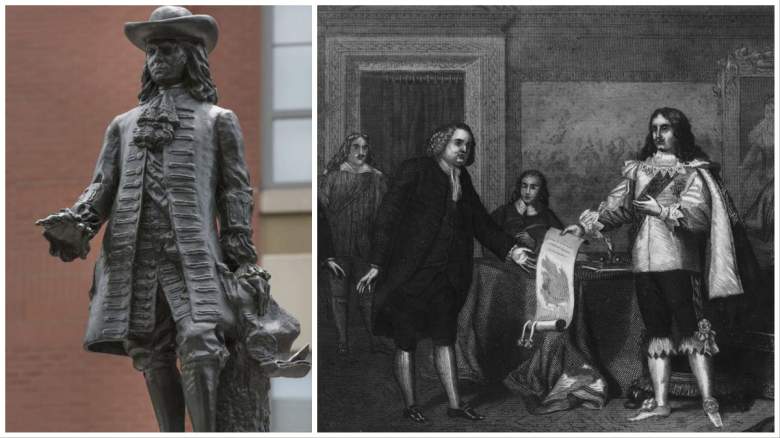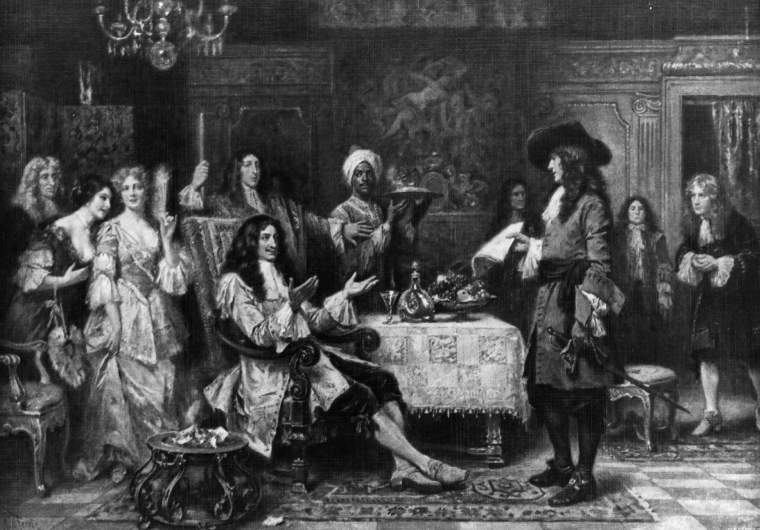
Picryl/Getty The William Penn statute in Welcome Park in Philadelphia, Pennsylvania.
The National Park Service has withdrawn its plans to remove a William Penn statue from “Welcome Park” in Philadelphia, Pennsylvania, after outcry.
“Independence National Historical Park has withdrawn the review of a draft proposal to rehabilitate Welcome Park and closed the public comment period. The preliminary draft proposal, which was released prematurely and had not been subject to a complete internal agency review, is being retracted. No changes to the William Penn statue are planned,” the National Parks Service said in a news release. “The National Park Service (NPS) remains committed to rehabilitating Welcome Park as the nation prepares to commemorate the 250th anniversary of the Declaration of Independence in 2026. Upon completion of all the necessary internal reviews, the park looks forward to engaging in a robust public process to consider options for refurbishing the park in the coming years.”
The release added, “The park is located on the site of William Penn’s home, the Slate Roof House, and is named for the ship, Welcome, which transported Penn to Philadelphia. The design and construction of Welcome Park was funded by the Independence Historical Trust and was completed in 1982.”
In its original a January 5 press release, the Park Service asked the public for input on the “proposed design for the rehabilitation of Welcome Park,” saying “The National Park Service proposes to rehabilitate Welcome Park to provide a more welcoming, accurate, and inclusive experience for visitors.”
The plan has received some criticism online.
According to US History.org, Penn “founded the Province of Pennsylvania, the British North American colony that became the U.S. state of Pennsylvania.” The site adds of Penn: “The democratic principles that he set forth served as an inspiration for the United States Constitution.”
According to US History.org, Penn became a Quaker, a group that “refused to bow or take off their hats to any man, and refused to take up arms.”
“William Penn was an English Quaker best known for founding the colony of Pennsylvania as a place for religious freedom in America,” Biography.com reports.
What is Welcome Park? According to the Cultural Landscape Foundation, “Situated in East Philadelphia close to the Delaware River, the plaza was conceived as an ‘open air’ museum by Venturi, Scott Brown and Associates. The project is the only site in the city dedicated to interpreting the life and ideas of its founder, William Penn.”
Here’s what you need to know:
The National Park Service Was Also Proposing to Remove William Penn’s ‘Slate Roof House’ From the Park

GettyCirca 1710, English quaker and colonial leader William Penn (1644 – 1718).
According to the National Park Service’s original press release, Welcome Park “was designed by the internationally acclaimed design firm Venturi & Scott Brown Associates. The park is located on the site of William Penn’s home, the Slate Roof House, and is named for the ship, Welcome, which transported Penn to Philadelphia. The design and construction of Welcome Park was funded by the Independence Historical Trust and was completed in 1982.”
The park service release explained:
The proposed rehabilitation of Welcome Park includes expanded interpretation of the Native American history of Philadelphia and was developed in consultation with representatives of the indigenous nations of the Haudenosaunee, the Delaware Nation, Delaware Tribe of Indians, the Shawnee Tribe, and the Eastern Shawnee Tribe of Oklahoma. The reimagined Welcome Park maintains certain aspects of the original design such as the street grid, the rivers and the east wall while adding a new planted buffer on three sides, and a ceremonial gathering space with circular benches. The Penn statue and Slate Roof house model will be removed and not reinstalled. In a separate and future effort, new exhibit panels will be installed on the south site wall to replace the Penn timeline.
The public “is invited to submit comments on this proposed design for the rehabilitation of Welcome Park for a 14-day period from January 8th – 21st, 2024 through the National Park Service’s Planning, Environment and Public Comment (PEPC) at https://parkplanning.nps.gov. Comments submitted through social media, phone calls, email or mail will not be accepted. All public comments must be received through PEPC by midnight Sunday, January 21st, 2024,” the release said.
The Cultural Landscape Foundation explains of Welcome Park:
Comissioned by the Friends of Independence Mall National Historic Park and opened in 1982, the design is laid out as a giant map of the original grid-iron street plan of Philadelphia constructed atop a marble ground plane. It includes miniature representations of significant features related to Penn, including the City Hall statue and his original slate-roof house. Within the plan, individual trees mark the four historic squares that were part of Penn’s original utopian plan of 1683.
The park is enclosed by two perimeter walls which are primed with a chronological, interpretive narrative that provides a biography of Penn. His farewell address to the city is engraved on the base of the statue model.
Penn is so closely associated with Philadelphia that a statue of Penn stands on top of City Hall.
William Penn Wrote the Constitution for the New Colony, Pennsylvania

Getty4th March 1681, English quaker William Penn (1644 – 1718) receives the charter for the state of Pennsylvania from King Charles II in payment of a debt owed to his father.
Penn “was the son of an admiral and landowner, and he was educated in theology and the law,” Biography.com reports.
According to that site, Penn “was jailed several times for his resistance to the Church of England,” and in 1681, “he received a royal charter to form a new colony in America, to be named Pennsylvania; he envisioned this territory as a peaceful refuge for members of all religious beliefs.”
In the newly named Pennsylvania, Penn formed “the new colony’s government, writing its constitution, distributing land to settlers and establishing positive, peaceful relations with the local Indians,” according to Biography.com.
He eventually returned to England, the site reports. According to a biography of Penn on Pennsbury Manor’s website, “Penn also navigated a peaceful relationship with the Lenape (Native Americans) in the area. Paying for land, inclusion in the jury system, and learning their language were just a few of the ways Penn approached and solicited the cooperation of the Lenape.”
According to US History.org, “Welcome Park is named for William Penn’s ship, the Welcome.”
READ NEXT: Wisconsin University Chancellor Accused of Starring in Online Porn Videos.
